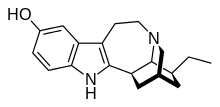Noribogaine
Noribogaine (actually O-desmethylibogaine), or 12-hydroxyibogamine, is the principal psychoactive metabolite of the oneirogen ibogaine. It is thought to be involved in the antiaddictive effects of ibogaine-containing plant extracts, such as Tabernanthe iboga.[1][2][3][4]
 | |
| Legal status | |
|---|---|
| Legal status |
|
| Identifiers | |
IUPAC name
| |
| CAS Number |
|
| PubChem CID | |
| ChemSpider |
|
| Chemical and physical data | |
| Formula | C19H24N2O |
| Molar mass | 296.407 g/mol g·mol−1 |
| 3D model (JSmol) | |
SMILES
| |
InChI
| |
| | |
Pharmacology
Noribogaine is a potent serotonin reuptake inhibitor,[5] but does not affect the reuptake of dopamine.[6] Unlike ibogaine, noribogaine does not bind to the sigma-2 receptor.[7][8] Similarly to ibogaine, noribogaine acts as a weak NMDA receptor antagonist and binds to opioid receptors.[9] It has greater affinity for each of the opioid receptors than does ibogaine.[10]
Noribogaine is a hERG inhibitor and appears at least as harmful to cardiac functioning as ibogaine.[11] The inhibition of the hERG potassium channel delays the repolarization of cardiac action potentials, resulting in QT interval prolongation and, subsequently, in arrhythmias and sudden cardiac arrest.[12]
κ-Opioid receptor
Recently, noribogaine has been determined to act as a biased agonist of the κ-opioid receptor (KOR).[13] It activates the G protein (GDP-GTP exchange) signaling pathway with 75% the efficacy of dynorphin A (EC50 = 9 μM), but it is only 12% as efficacious at activating the β-arrestin pathway.[13] Moreover, due to its very low efficacy on the β-arrestin pathway, noribogaine blocked dynorphin A activation of the pathway (IC50 = 1 μM) and hence functioned as an antagonist of it.[13]
The β-arrestin pathway is thought to be responsible for the dysphoric and aversive effects of KOR activation,[14] and its lack of activation by noribogaine may be the reason for the lack of dysphoric effects of the drug.[13] This biased agonist/antagonist action of noribogaine at the KOR is unique to it relative to other iboga alkaloids and related compounds such as ibogaine and 18-methoxycoronaridine (18-MC).[13] Moreover, it has been hypothesized that it may give noribogaine unique properties such that it may have the analgesic and antiaddictive effects of KOR agonists without the anxiogenic, dysphoric, or anhedonic effects that are typical of them.[13]
See also
References
- Mash DC, Ameer B, Prou D, Howes JF, Maillet EL (2016). "Oral noribogaine shows high brain uptake and anti-withdrawal effects not associated with place preference in rodents". J. Psychopharmacol. (Oxford). 30 (7): 688–97. doi:10.1177/0269881116641331. PMID 27044509.
- Glick SD, Maisonneuve IS (May 1998). "Mechanisms of antiaddictive actions of ibogaine". Annals of the New York Academy of Sciences. 844: 214–26. doi:10.1111/j.1749-6632.1998.tb08237.x. PMID 9668680.
- Baumann MH, Pablo J, Ali SF, Rothman RB, Mash DC (2001). "Comparative neuropharmacology of ibogaine and its O-desmethyl metabolite, noribogaine". The Alkaloids: Chemistry and Biology. 56: 79–113. doi:10.1016/S0099-9598(01)56009-5. PMID 11705118.
- Kubiliene A, Marksiene R, Kazlauskas S, Sadauskiene I, Razukas A, Ivanov L (2008). "Acute toxicity of ibogaine and noribogaine". Medicina (Kaunas, Lithuania). 44 (12): 984–8. PMID 19142057.
- Max M. Houck (26 January 2015). Forensic Chemistry. Elsevier Science. pp. 164–. ISBN 978-0-12-800624-5.
- Baumann, Michael H.; Rothman, Richard B.; Pablo, John P.; Mash, Deborah C. (May 1, 2001). "In Vivo Neurobiological Effects of Ibogaine and Its O-Desmethyl Metabolite, 12-Hydroxyibogamine (Noribogaine), in Rats". Journal of Pharmacology and Experimental Therapeutics. 297 (2): 531–539. ISSN 1521-0103. PMID 11303040.
- Paul Gahlinger (30 December 2003). Illegal Drugs. Penguin Publishing Group. pp. 304–. ISBN 978-1-4406-5024-6.
- Kenneth R. Alper; Stanley D. Glick (2001). Ibogaine: Proceedings from the First International Conference. Gulf Professional Publishing. pp. 107–. ISBN 978-0-12-053206-3.
- Donald G. Barceloux (20 March 2012). Medical Toxicology of Drug Abuse: Synthesized Chemicals and Psychoactive Plants. John Wiley & Sons. pp. 869–. ISBN 978-0-471-72760-6.
- Pearl, S. M.; Herrick-Davis, K.; Teitler, M.; Glick, S. D. (Mar 27, 1995). "Radioligand-binding study of noribogaine, a likely metabolite of ibogaine". Brain Research. 675 (1–2): 342–344. doi:10.1016/0006-8993(95)00123-8. ISSN 0006-8993. PMID 7796150.
- Alper K, Bai R, Liu N, Fowler SJ, Huang XP, Priori SG, Ruan Y (2016). "hERG Blockade by Iboga Alkaloids". Cardiovasc. Toxicol. 16 (1): 14–22. doi:10.1007/s12012-015-9311-5. PMID 25636206.
- Litjens RP, Brunt TM (2016). "How toxic is ibogaine?". Clin Toxicol. 54 (4): 297–302. doi:10.3109/15563650.2016.1138226. PMID 26807959.
- Maillet EL, Milon N, Heghinian MD, Fishback J, Schürer SC, Garamszegi N, Mash DC (2015). "Noribogaine is a G-protein biased κ-opioid receptor agonist". Neuropharmacology. 99: 675–88. doi:10.1016/j.neuropharm.2015.08.032. PMID 26302653.
- Ehrich JM, Messinger DI, Knakal CR, Kuhar JR, Schattauer SS, Bruchas MR, Zweifel LS, Kieffer BL, Phillips PE, Chavkin C (2015). "Kappa Opioid Receptor-Induced Aversion Requires p38 MAPK Activation in VTA Dopamine Neurons". J. Neurosci. 35 (37): 12917–31. doi:10.1523/JNEUROSCI.2444-15.2015. PMC 4571610. PMID 26377476.
| |||||||||||||||||||||||||||||||||||||||||||||||||||||||||||||||||||||||||||||||||||||||||||||||||||||||||||||||||||||||||||||||||||||||||||||||||||||||||||||||||||||||||||||||||||||||||||||||||